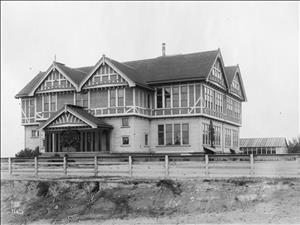This history of Lowell Elementary School is taken from the second edition of Building for Learning: Seattle Public School Histories, which includes histories of every school building used by the district since its formation around 1862. The original essay was written for the 2002 first edition by Nile Thompson and Carolyn J. Marr, and updated for the 2024 edition by HistoryLink contributor Tom G. Heuser.
Pontius Addition
Between 1889 and 1892, the Seattle School District constructed eight new schools, more than doubling the number of public-school buildings. Pontius School, in the Pontius Addition of the northeast section of the city, ultimately honored R. W. Pontius, a member of the Seattle School Board in the 1860s. This area, today known as Capitol Hill, was sparsely populated, with only a few scattered homes and unimproved streets.
The eight-room brick building was a Tudor-style design. In the 1890-1891 school year, the new school opened to 261 students in grades 1-6. Seventh and eighth grades were added over the next two years. Children going to school from the area near Pine Street and east of Broadway followed a path along the east side of a wetland. The name of Pontius School was short-lived. In 1891 it was renamed Columbia School. Over the next decade, many new homes were built in the neighborhood and enrollment at the school doubled by 1902. In 1904, an addition to the north side of the building increased the number of classrooms to 16.
After the annexation of an area southeast of Seattle in 1908, the Seattle School District included Columbia City School as well as Columbia School. The ensuing confusion led to the renaming of the Capitol Hill school in 1910. Following a pattern of commemorating famous Americans, the school was called Lowell, honoring James Russell Lowell, a nineteenth century poet, scholar, and diplomat from Massachusetts. A portrait of Lowell was installed in the main hallway together with his autograph.
In 1913, the Lowell School was enlarged, and plans for another addition got underway. Construction began in late 1917, but because of wartime shortages the addition was not completed until 1919. The new brick wing, with eight classrooms, was located to the south of the older structure and connected by a gabled passageway. In 1921, the district purchased adjoining property to the north between Roy and Aloha Streets. This was intended as a junior high school site, but these plans were abandoned. The site became a playfield for Lowell.
Following the April 1949 earthquake, students in grades 1-6 from the severely earthquake damaged Cascade School were bused 11 blocks to Lowell. Cascade never reopened and these pupils became part of the Lowell student body.
Razed and Rebuilt
The original 1890 wood structure was torn down in 1959 and replaced in 1960 by an addition containing a gymnasium, auditorium, and 11 classrooms. Lowell parents had repeatedly petitioned the school board for a gymnasium. Part of the new wing was devoted to a special education program. That program was formerly at Warren Avenue School, demolished for the 1962 Seattle World’s Fair. The program moved to Lowell after being temporarily housed at Holgate for a year. Lowell’s program for the handicapped provided instruction for kindergarten through high school students in need of individualized physical, occupational, and speech therapies. Enrollment in 1964-1965 included 108 special education and 391 general education students. In 1973, new playground facilities were installed, making Lowell the only school in the nation with a play area and play structure designed for all students with physical disabilities. In 1993, the outdoor play area was again improved to allow equal access for the physically and mentally challenged students who comprised about 75 percent of the school’s population. In 2020, the playground was again updated to accommodate all children no matter their physical abilities, beyond what the ADA requires.
Over the years, Lowell acquired a number of pieces of art. Significant among these pieces is a sculpture by Rita Kepner (Big Log, 1970) donated to the school in 1977. However, it was removed from the school by a principal in 2005 and placed in the Records and Archives Department for safe keeping. Kepner is listed in Who’s Who in American Art and her sculptures are in prominent places across the globe.
In fall 1997, the Accelerated Progress Program (APP; now Highly Capable Cohorts) moved into the building, which it shared with the special education program. The blending of the two programs succeeded for many years, especially in art and music classes where the students were co-taught. This program arrangement ended in 2010. Many less severe special needs students moved into general education programs, while the APP program moved to Lincoln High School. This move was designed to alleviate overcrowding at Lowell caused in part by the absorption of students from the closing of T. T. Minor School in 2009. As a result, enrollment at Lowell went from 545 in 2010 to 188 in 2011, but steadily increased again, peaking at 374 in 2017.
When Lowell transitioned to a neighborhood school, it changed its focus to better serve the increasingly diverse Capitol Hill and downtown areas. Lowell serves learners of all abilities who speak 20 different languages, as well as many students who receive McKinney-Vento services. In 2020, planning began for the conversion of one classroom into a student health center; the work was completed in 2021.
History
Pontius School
Location: 11th Avenue N and E Mercer Street
Building: 8-room wood
Architect: Saunders & Houghton
Site: 1.66 acres
1890: Opened
1891: Renamed Columbia School
1904: Addition (James Stephen)
1910: Renamed Lowell School
1913: Site expanded
1919: Addition (Edgar Blair)
1921: Site expanded to 3.9 acres
1959: 1890 structure demolished
1960: Addition (John Graham & Co.)
2007: Exterior renovations and roof upgrades
Lowell Elementary in 2023
Enrollment: 279
Address: 1058 E Mercer Street
Nickname: Dragons
Configuration: K-5

